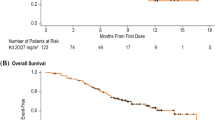Abstract
Purpose: To evaluate the impact of an additive therapy with an oral enzyme (OE) preparation given for more than 6 months additionally to standard combination chemotherapy (vincristine/melphalan/cyclophosphamide/prednisone (VMCP)- or methylprednisolone/vincristine/CCNU/cyclophosphamide/melphalan (MOCCA)-regimen) in the primary treatment of patients with multiple myeloma stages I–III. Methods: A cohort of 265 patients with multiple myeloma stages I–III was consecutively treated at our institution in two parallel groups (control group (n=99): chemotherapy ±OE for less than 6 months; OE-group (n=166): chemotherapy + OE for more than 6 months). The median follow-up time in the stages I, II, and III for the OE-group was 61, 37, and 46.5 months, respectively; for the control group the respective values were 33, 51.5, and 31.5 months. The primary endpoint of the study was disease-specific survival. Secondary endpoints were response to therapy, duration of first response and side effects. The chosen method for evaluation was the technique of a retrolective cohort analysis with a concurrent control group. Survival analysis was performed by the Kaplan-Meier method and multivariate analysis was done with the Cox proportional hazards model. Results: Significantly higher overall response rates and longer duration of remissions were observed in the OE-group. Primary responders showed a longer mean survival time than non-responders. Additive therapy with OE given for more than 6 months decreased the hazard of death for patients at all stages of disease by approximately 60%. Observation time was not long enough to estimate the median survival for patients at stages I and II; for stage III patients it was 47 months in the control group versus 83 months for the patients treated with OE (P=0.0014) which means a 3-year gain of survival time. Significant prognostic factors for survival, in the Cox regression analysis, were stage of disease and therapy with OE. The OE-therapy was generally well tolerated (3.6% of patients with mild to moderate gastrointestinal symptoms). Conclusion: OEs represent a promising new additive therapy in multiple myeloma which will be further evaluated in a randomized phase III trial in the USA.
Similar content being viewed by others
Author information
Authors and Affiliations
Rights and permissions
About this article
Cite this article
Sakalová, A., Bock, P., Dedík, L. et al. Retrolective cohort study of an additive therapy with an oral enzyme preparation in patients with multiple myeloma. Cancer Chemother Pharmacol 47 (Suppl 1), S38–S44 (2001). https://doi.org/10.1007/s002800170008
Issue Date:
DOI: https://doi.org/10.1007/s002800170008




